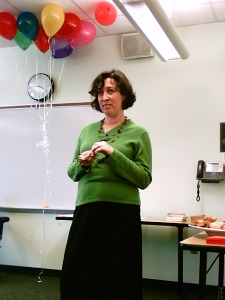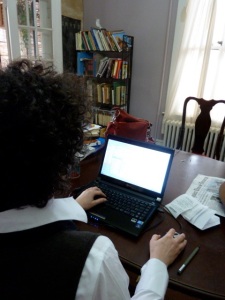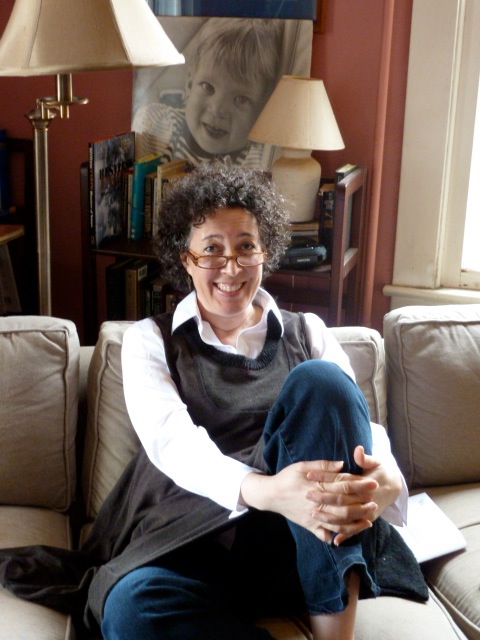By Phyllis Theroux, Guest Contributor
Twitter: @FEASTtweets
Facebook: F.E.A.S.T
In 2002, Laura Collins was just beginning her career in Warrenton, Virginia as a serious stay-at-home writer when her 14-year-old daughter was diagnosed with anorexia nervosa. Her daughter’s various therapists told her and her husband to back off while they took over .
” I was absolutely gobsmacked by the diagnosis . It was the most isolating thing I had ever faced.” Laura
But their daughter did not get better. Finally, they decided to trust their “bravest parental instincts” and manage her care themselves. Only later did the writer Collins kick in. After their daughter recovered, she wrote “Eating With Your Anorexic” which describes the ultimately successful route they took.
Collins’ niche market now is parents. In 2008, she created a organization, F.E.A.S.T. ( Families Empowered and Supporting Eating Disorders) which offers a variety of services and is the only non-profit of its kind.
Of two things Laura is sure: an eating disorder is a brain disorder, and parents don’t cause it although they can make it worse. This makes her a gadfly in the Eating Disorder world.
Not long ago I spent the day with Laura at her northern Virginia house, which at 7:30 in the morning is full of the click of metal taps on a hardwood floor. Collins is a tap dancer. More on that later…
PHYLLIS: The last time I saw you, Laura, was in 2000, when you came to my writing seminar. Now you’ve published one book, with another on the way, and you are an important player in the mental health-eating disorder world. My student has become a teacher! I’m very proud of you.
 LAURA: I never dreamed I would end up doing this. But nobody else was, and I don’t think other families should have to go through what we did.
LAURA: I never dreamed I would end up doing this. But nobody else was, and I don’t think other families should have to go through what we did.
PHYLLIS: What was it like when you were told your daughter had anorexia?
LAURA: I was absolutely gobsmacked by the diagnosis. It was the most isolating thing I had ever faced. And what was worse was the lack of coherent guidance from the doctors we consulted.
It’s pretty frightening to be dealing with an illness where one in ten die and 30% don’t get well and most of the professionals contradict each other.
PHYLLIS: Laura, how many people suffer from anorexia nervosa?
LAURA: We don’t know. Most estimates are that about l% of the population suffers from it. We also know that with traditional treatment, 1/3 of the patients recover, l/3 stay sort of marginally ill, and l/3 are seriously disabled or dead.
PHYLLIS: How does F.E.A.S.T. differ from all the other ED websites and organizations? I know you have an international bulletin board where families whose children are suffering from ED can find each other.
LAURA: We have a laser focus upon the caregiver role. That focus changes our perspective.
PHYLLIS: After spending the day with you, this is what I wrote in my journal:
“Every morning, Collins rises, has breakfast, and straps on her high-heeled tap dancing shoes. For 20 minutes she whirls around her glassed-in back porch, accompanied by 1940’s radio music.
Then she moves into her dining room, flips open her laptop and fixes her eyes upon the screen. There are scores of new e-mails from from parents, professionals, and organizations inviting her to attend or speak. It is a dark universe full of frightened families where Collins is the only steady source of light. Exhausting work!”
LAURA: That’s why I tap dance. It isn’t for anyone but the goldfish in my nearby pond. It centers all my senses and slaps me into my day.
PHYLLIS: Can you give me examples of these parents who become F.E.A.S.T users?
LAURA: Right now, there is a mother in Scotland with a seven-year-old who says that “soldiers in her head” are telling her she can’t eat. She hasn’t gained any weight in three years. The mother found our forum and told us about her situation. Dozens of people told her to please, please get her daughter to a doctor or an emergency room.
There’s a family on the west coast whose daughter is an adult and the parents are not allowed to intervene except when she’s hospitalized – which is often.
In Virginia, a mother called because her son couldn’t drink water because he was so phobic of calories. She needed to learn about treatment options from other parents because her pediatrician had no ideas or guidance.
“Life-saving care should not depend upon one frightened mother who can’t get a straight answer…”
PHYLLIS: Your daughter got anorexia nervosa nine years ago. Hasn’t this attitude toward parents being a big part of the problem changed?
LAURA: The most up-to-date medical professionals are clear that parents aren’t the problem. (Collins has written a new book, “Parents Don’t Cause Eating Disorders” with Dr. Tomas J. Silber from the Children’s National Medical Center.)
But someone recently said at an Academy for Eating Disorders International Forum that parents of ED patients are “toxic.” And when I and others spoke up and asked why is it acceptable for someone to say this and for no one to contradict it they actually shut down the dialogue. People felt quote unquote “unsafe.”
PHYLLIS: How does it feel to be the most popular kid at the party?
LAURA: If I have to make a nuisance of myself and make people feel unsafe and worried, maybe that’s what it takes, because people and families are being destroyed. Life-saving care should not depend upon one frightened mother who can’t get a straight answer or help from anyone but strangers on the internet.
 PHYLLIS: How do you differ from mainstream ED thinking?
PHYLLIS: How do you differ from mainstream ED thinking?
LAURA: It appears that ED is an illness, like schizophrenia or autism, both of which, by the way, were at one time believed to be the fault of the parents. Now we know that this is not the case.
PHYLLIS: Who is “we”?
LAURA: The growing number of scientists, clinicians and activists who believe in evidence-based treatment advice. ED is now defined, by the NIMH as a brain disorder. You would think that this would be a pretty benign statement.
But because so many people in the field are recovered ED sufferers and they believe that it came about because they decided to recover, it’s difficult for them to hear someone say, no, this was a problem in your brain, and you fixed it. That’s different than saying you were thinking incorrectly, but you were very brave and you decided not to think this way anymore.
“People can fully recover and live normal lives free of their eating disorder…”
PHYLLIS: Is ED a brain disorder that can be cured?
LAURA: It is a life-long, genetic predisposition but not necessarily a lifelong illness. People can fully recover and live normal lives free of their eating disorder, particularly if caught early and treated assertively.
PHYLLIS: You may be considered controversial among professionals, but I assume that parents are more receptive to your view that ED is disease that isn’t the parents’ fault.
LAURA: Not all parents like my message either. Guilt is a seductive frame of mind. It paralyzes us, excuses us from doing anything. You say “oh, it’s all my fault and I can’t change the past.” I’ve been there. I’ve definitely done that. I know it sounds self-serving to say this isn’t my fault and I can help, but unless parents start doing that we take a great risk that our kids won’t get well.
“Anyone can set up shop and say they are treating eating disorders.”
PHYLLIS: How many professional medical doctors are there who you think are qualified to treat ED?
LAURA: I have no idea. There are no qualifications for treating it. There is no specialty, no training, no boards. Anyone can set up shop and say they are treating eating disorders. And I’ve been in this field for awhile and anyone who tries to propose there there should be qualifications gets blasted. It’s heresy to question people. The wagons get circled, and the push back gets very personal.
PHYLLIS: How popular are you when you raise this issue in the ED community?
LAURA: Not very. And let me be clear about the people working with ED. They are passionate and caring people. Everyone I’ve met in this field would be OK with it if they became irrelevant tomorrow. If there was a pill that would cure eating disorders, they would happily move on to other things. These are not people who do this for money or fame. They believe in what they are doing.

PHYLLIS: What do we know with any certainty about this disease?
LAURA: Very little and that’s the problem. There are only a few dots on the map and the rest is empty. The ED field is operating as if the blank map is the true part. We haven’t studied any of it.
PHYLLIS: Why hasn’t more research been done?
LAURA: There are lots of tiny survey-based data collections going on, but I find most of it is crap – like whether the mothers of ED sufferers are on diets, or if the sufferers are going on Facebook too much. I’m not joking.
More serious studies aren’t being done because the drop-out rate among eating disorder patients is so high except among young children whose parents force them to remain in treatment.
PHYLLIS: Why isn’t there so little grant money out there for a disease that takes so many lives?
LAURA: Because the families of the sufferers have not lobbied for it. Dr. Thomas Insel, the Director of the National Institute of Mental Health, told me years ago that until ED parents get involved and lobby for evidence-based research, they won’t make any headway with ED. In every health field that’s how it happens. That’s why I started F.E.A.S.T.
PHYLLIS: In our conversation, you refer a lot to “evidence-based” treatment. But isn’t the recovery route the same, no matter what you believe, i.e., re-feeding the sufferer, stopping the binging and purging, the exercising, getting good therapy?
LAURA: The belief that the patient is in charge is one big difference. Most ED treatment puts the patient back in control for weeks or a few months. I don’t think that is long enough. It is like giving only the first dose of an antibiotic and wondering why the infection comes back stronger.
“To me the greatest myth is that the patients chose to be ill…”
PHYLLIS: What do you consider some of the myths about how one gets an eating disorder?
LAURA: That the patients chose to be ill, that they caught it from their environment. This belief leads to very poor treatment. Most of the treatment offered to families involves some kind of separation of the patient from their families. Treatment is done individually with therapy, in hospital or residential settings. There is zero evidence that residential and inpatient care improves outcome, yet they are the norm.
PHYLLIS: Why isn’t this a reasonable way to treat someone with an eating disorder, to take them off the streets and out of their own control for awhile during which they they are nursed back to health?
 LAURA: Because it is based upon catching people when they’re already so ill and then throwing them back in the water before they’re well. It is very well-meaning but demonstrably unhelpful.
LAURA: Because it is based upon catching people when they’re already so ill and then throwing them back in the water before they’re well. It is very well-meaning but demonstrably unhelpful.
PHYLLIS: You know that a friend of my family recently returned from a treatment center like the one you described, in fact, that you recommended. How do you square your opinion of treatment centers in general with your specific recommendation?
LAURA: I can’t square it. The person who runs that particular treatment center has worked miracles, and I am not about to deny her that gift, or prevent someone who needs a miracle from going there just because we aren’t philosophically on the same page. I start with the science but acknowledge and celebrate the mystery as well.
PHYLLIS: What about the fact that being thin is such a value in our culture? Doesn’t this play a big part in the mentality of someone with an eating disorder?
LAURA: Do soap commercials play a big role in obsessive compulsive disorders? When my daughter became ill with anorexia, it looked like the same sort of body image distress that I and many women I know also experience. It took me a long time to recognize ED as a biological predisposition.
“ED is a treatable disease, like ulcers.”
PHYLLIS: What lies ahead for people with ED?
LAURA: I believe the data we have offers optimism. The landscape is of hope. Even though I’m seen as a negative person in this field, I believe my message is positive. ED is a treatable illness, like ulcers.
PHYLLIS: Ulcers?
LAURA: Yes, until very recently, the medical profession believed that ulcers were caused by stress, by the outside environment, perhaps in combination with poor diet. Then, in 1989, along came two scientists who had a hunch that it wasn’t stress but a bacteria in the stomach of people who got ulcers, called H.pylori.
One of them proved it by swallowing a bunch of pills with H.pylori in them, and he immediately got ulcers. A simple course of antibiotics cleared it up.
PHYLLIS: That was quite a significant swallow.
LAURA: They got the Nobel Prize for it.
PHYLLIS: Thank you, Laura, for this thought-bending interview. The first International F.E.A.S.T. Convention takes place in northern Virginia this November. Some of our readers may want to attend.
___________________________________________________________________
Phyllis Theroux is an essayist, author (recently of “The Journal Keeper“), and writing teacher who has been an EYE subject. She suggested profiling Laura Collins, and we at the EYE thought this story would be an interesting addition to the website. Thanks, Phyllis, for the suggestion and for introducing us to Laura.





Leave a Reply